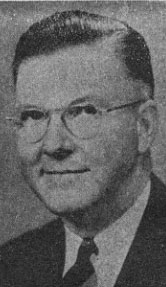About
Department History
Early Years (1899 - 1908)
 The Village of Endicott is named after Henry B. Endicott, founder of the Endicott Shoe Factory. In 1899, Mr. Endicott partnered with his factory foreman, George F. Johnson, to form the Endicott-Johnson Corporation (E-J). The Endicott community was planned by E-J and in 1906, the Village of Endicott was incorporated. Within six-weeks, the new Village of Endicott established a police force. At that time, the neighboring Village of Union (now known as the Union District) was separate from Endicott and had its own police department.
The Village of Endicott is named after Henry B. Endicott, founder of the Endicott Shoe Factory. In 1899, Mr. Endicott partnered with his factory foreman, George F. Johnson, to form the Endicott-Johnson Corporation (E-J). The Endicott community was planned by E-J and in 1906, the Village of Endicott was incorporated. Within six-weeks, the new Village of Endicott established a police force. At that time, the neighboring Village of Union (now known as the Union District) was separate from Endicott and had its own police department.
Chief Towne served for one year and was the entire police force. He was succeeded by Frank Evans, who served through the end of 1907. James Conlon succeed Mr. Evans, serving from January through April, 1908, when he resigned.
read more
George Towne, First Police Chief (1906)
Chief Frank Evans (1907)
Chief James Conlon, January – April (1908)
Chief Daniel Frutiger (1913-1935)
 In 1913, Daniel Frutiger was appointed to Chief of Police. Chief Frutiger served in the position from 1913-1935.
In 1913, Daniel Frutiger was appointed to Chief of Police. Chief Frutiger served in the position from 1913-1935.
At the time of his appointment, Chief Frutiger collected a salary of $80.00 per month. It was a common sight to see Frutiger patrolling the Village from his side-car motorcycle. 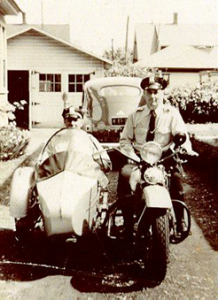 With no police vehicle capable of transporting prisoners, Frutiger was known to have hauled in drunks and prisoners using a wheel barrow. The first police lock up was described as being a square, bottomless wire cage and some offenders placed in the lock up were known to have simply lifted the cage and walked away.
With no police vehicle capable of transporting prisoners, Frutiger was known to have hauled in drunks and prisoners using a wheel barrow. The first police lock up was described as being a square, bottomless wire cage and some offenders placed in the lock up were known to have simply lifted the cage and walked away.
A New Municipal Building (1913)
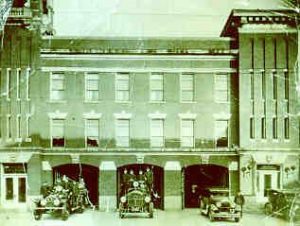 In 1913 a new municipal building was erected in the ten block of Washington Avenue. The building contained the Fire and Police Departments, as well as a bowling alley in the basement and a gymnasium on the top floor.
In 1913 a new municipal building was erected in the ten block of Washington Avenue. The building contained the Fire and Police Departments, as well as a bowling alley in the basement and a gymnasium on the top floor.
The M&T bank is presently located where this building once stood.
Village Merging (1921)
In 1921, the Villages of Union and Endicott merged to become the incorporated Village of Endicott and it was in that same year that the “Endicott Police Bureau” was established when the two police forces combined.
Populating Growth (1920's)
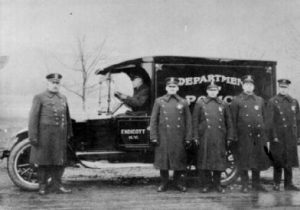 During the 1920’s, Endicott’s population grew quickly due to the E-J Corporation, which employed an estimated 20,000 people in Endicott, Johnson City and Binghamton factories. As the era of the “horseless carriage” evolved, the police department continued to grow and also began using automobiles.
During the 1920’s, Endicott’s population grew quickly due to the E-J Corporation, which employed an estimated 20,000 people in Endicott, Johnson City and Binghamton factories. As the era of the “horseless carriage” evolved, the police department continued to grow and also began using automobiles.
First Endicott Officer Shot
Sometime in the mid-twenties, Captain Earl Bedford, is believed to have been the first Endicott Police officer ever shot in the line of duty. Captain Bedford was reportedly chasing a wanted person when the suspect hid in a coal bin. When Captain Bedford moved in to make the arrest, he was shot in the hand by the suspect. Captain Bedford eventually placed into custody and survived his gunshot wounds.
Endicott Car Chase
A story involving Sergeant Earl Van Etten coincides with the automobile era. Sergeant Van Etten was on his walking beat when vehicle, identified as a Hudson sped by him; the driver ignoring blasts from Van Etten’s whistle as he kept on going. The operator of a second vehicle (a Willys-Knight), came up quickly in pursuit of the Hudson and stopped for the Sergeant Van Etten, explaining that the people in the car he was chasing had been robbing gas stations in Tioga County. Van Etten commandeered the Willys-Knight by jumping on to its side board, ordering the driver to “Follow that car!” As the pursuit hastened, Van Etten used his marksmanship to skillfully shoot out one of the tires of the Hudson, bring the chase to a stop. The driver of the Hudson and his accomplice were arrested and it was learned they were escapees from the state of Massachusetts who were in a stolen car and had robbed several gas stations along their travels to Endicott.
Twelve-man Police Department (1925)
In 1925 the force was twelve strong under Chief Frutiger, with a single telephone, and three patrol vehicles: a patrol car; a patrol wagon; and a motorcycle. Though eleven officers worked, the department only had ten revolvers. It appears that two of the officers had to share a gun!
Prohibition Era (1930's)
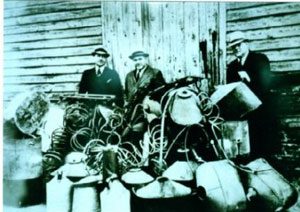 The Prohibition era of the 1930’s brought about many clandestine stills in people’s homes. To avoid detection, home distillers would conceal their operation by covering windows and doing whatever else they could to prevent detection. To combat these problems, the Department developed a “Drill Team.” When the police suspected a still operation, the “drill team” would use an auger to drill a hole in the wall, peek inside to obtain the evidence they needed, then move in and shut down the still.
The Prohibition era of the 1930’s brought about many clandestine stills in people’s homes. To avoid detection, home distillers would conceal their operation by covering windows and doing whatever else they could to prevent detection. To combat these problems, the Department developed a “Drill Team.” When the police suspected a still operation, the “drill team” would use an auger to drill a hole in the wall, peek inside to obtain the evidence they needed, then move in and shut down the still.
"The Black Mariah" Ambulance (1935)
 In 1935, the increasing population in the area brought with it numerous automobiles and automobile accidents. Identifying the need for an ambulance, the acquired a 1935 Ford ambulance nicknamed “The Black Mariah.” The Black Mariah is still around today and the owner lives just over the state border in Pennsylvania. The Police Department continued an ambulance service up until 1978, when it was taken over by the Union Volunteer Emergency Squad.
In 1935, the increasing population in the area brought with it numerous automobiles and automobile accidents. Identifying the need for an ambulance, the acquired a 1935 Ford ambulance nicknamed “The Black Mariah.” The Black Mariah is still around today and the owner lives just over the state border in Pennsylvania. The Police Department continued an ambulance service up until 1978, when it was taken over by the Union Volunteer Emergency Squad.
W.I.K.E.
 In the 1930’s, two-way police radios were coming into service and, just like today, radio operators were required to have call letters. Chief Wike’s name went around the world, when the Endicott Police radio call letters were W.I.K.E, in honor of his last name. It was so unusual, the Endicott Police Department was mentioned in an edition of “Ripley’s Believe It or Not.”
In the 1930’s, two-way police radios were coming into service and, just like today, radio operators were required to have call letters. Chief Wike’s name went around the world, when the Endicott Police radio call letters were W.I.K.E, in honor of his last name. It was so unusual, the Endicott Police Department was mentioned in an edition of “Ripley’s Believe It or Not.”
Department Continues to Grow
 The department continued to evolve under Chief Wike, who during his tenure served as president of the State Chiefs of Police Association and later as Executive Secretary of the International Association of Chiefs of Police after his retirement from Endicott. In 1942, under Chief Wike, the department grew to a twenty-four man force. In 1949, the “Endicott Daily Bulletin” documented data from a report submitted by Chief Wike to the state commissioner of public safety listing 366 arrests made by the Endicott Police during the month of February; 157 “calls and complaints.” The report also documented 14 ambulance calls; $558 property reported stolen and $550 in property recovered. Prisoner meals cost the department $15.40 for the month and three police cars covered 6,889 miles during the month.
The department continued to evolve under Chief Wike, who during his tenure served as president of the State Chiefs of Police Association and later as Executive Secretary of the International Association of Chiefs of Police after his retirement from Endicott. In 1942, under Chief Wike, the department grew to a twenty-four man force. In 1949, the “Endicott Daily Bulletin” documented data from a report submitted by Chief Wike to the state commissioner of public safety listing 366 arrests made by the Endicott Police during the month of February; 157 “calls and complaints.” The report also documented 14 ambulance calls; $558 property reported stolen and $550 in property recovered. Prisoner meals cost the department $15.40 for the month and three police cars covered 6,889 miles during the month.
Chief Leon Coleman (1954-1960)
 In late 50’s under Chief Coleman, the department grew to 34 officers. The communication system grew to include a two-way radio system, three headquarters telephones and 12 police call boxes throughout the village. The vehicle fleet included three patrol cars, an ambulance, a motorcycle and a combination auxiliary ambulance-patrol wagon. Armaments included 36 service revolvers, seven rifles, three shotguns, two submachine guns and a tear-gas gun
In late 50’s under Chief Coleman, the department grew to 34 officers. The communication system grew to include a two-way radio system, three headquarters telephones and 12 police call boxes throughout the village. The vehicle fleet included three patrol cars, an ambulance, a motorcycle and a combination auxiliary ambulance-patrol wagon. Armaments included 36 service revolvers, seven rifles, three shotguns, two submachine guns and a tear-gas gun
Chief Delbert Pembridge (1960-1977)
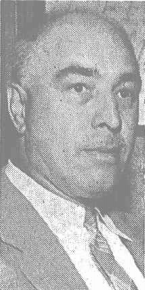 In 1960 Delbert Pembridge was appointed Chief and the department grew to 41 officers, which included 22 uniformed patrolmen and 19 other positions including plainclothes officers, traffic, parking and communications personnel. Village boundaries expanded and the police department took on new duties, while the workweek for police officers dropped from 6 to 5 days per week. The last of the police department’s motorcycles were phased out during this time period and the police department expanded training, including special training in Riot Control and use of RADAR in vehicle and traffic enforcement.
In 1960 Delbert Pembridge was appointed Chief and the department grew to 41 officers, which included 22 uniformed patrolmen and 19 other positions including plainclothes officers, traffic, parking and communications personnel. Village boundaries expanded and the police department took on new duties, while the workweek for police officers dropped from 6 to 5 days per week. The last of the police department’s motorcycles were phased out during this time period and the police department expanded training, including special training in Riot Control and use of RADAR in vehicle and traffic enforcement.
Safety at Public Events
 In the 70’s, the department saw a precursor to the current concerts held during the Dick’s Sporting Goods Open, when it was responsible for the public safety of 8,000 spectators attending a rock concert by the band “Blood, Sweat & Tears” in Union-Endicott’s Ty Cobb Stadium. No problems occurred inside the concert venue but the fan base included another 2,000 fans outside the stadium listening to the music on area hillsides, some of whom were arrested for causing problems including throwing rocks at police cars. In 1971, the other precursor to the Dick’s Sporting Goods Open found a home at EnJoie Golf Course as one-day satellite event for the PGA Tour. By 1973, the B.C. Open was one of the 42 major events on the PGA tour.
In the 70’s, the department saw a precursor to the current concerts held during the Dick’s Sporting Goods Open, when it was responsible for the public safety of 8,000 spectators attending a rock concert by the band “Blood, Sweat & Tears” in Union-Endicott’s Ty Cobb Stadium. No problems occurred inside the concert venue but the fan base included another 2,000 fans outside the stadium listening to the music on area hillsides, some of whom were arrested for causing problems including throwing rocks at police cars. In 1971, the other precursor to the Dick’s Sporting Goods Open found a home at EnJoie Golf Course as one-day satellite event for the PGA Tour. By 1973, the B.C. Open was one of the 42 major events on the PGA tour.
Chief Lee H. Sands (1977 - 1983)
Chief Lee H. Sands took the reins of the department from Chief Pembridge in 1977. During Chief Sands’ tenure, officers in the department benefitted from a county-wide radio system installed to allow officers to communicate with one another. Youth were invited into the police department to participate in the Endicott Police Junior Rifle Club that had been in existence for decades, teaching youth firearms and marksmanship skills. Also during Chief Sands’ time in office, police officers of the department were outfitted with body armor for the first time.
Chief Walter D. Ford Jr. (1983-1994)
 Walter D. Ford Jr. was appointed Chief of Police of the 38 man department on May 1, 1983. Chief Ford oversaw the Endicott Police Department being among the first in the region to use computers.
Walter D. Ford Jr. was appointed Chief of Police of the 38 man department on May 1, 1983. Chief Ford oversaw the Endicott Police Department being among the first in the region to use computers.  In 1984, the Village of Endicott was showcased nationally when President Ronald Reagan visited IBM and spoke at Ty Cobb Stadium during a campaign stop.
In 1984, the Village of Endicott was showcased nationally when President Ronald Reagan visited IBM and spoke at Ty Cobb Stadium during a campaign stop.
First Bomb Squad in the Southern Tier (1985)
In 1985, the Endicott PD established the only fully-equipped bomb squad in the Southern Tier through an IBM Corp. donation of a van; trailer; bomb blanket; bomb basket; remote-controlled robot; and funding to train four patrolmen in the craft.
Switch to Beretta semi-automatic pistol (1989)
In July of 1989, the department switched from the .357 magnum revolver to .9mm Beretta semi-automatic pistol.
Bicycle Patrol (1995)
In July of 1995 a Bicycle Patrol was established in the police department through a donation from the supermarket Price-Chopper.
SWAT formed (1995 - 1996)
In 1995 & 1996 the Special Response Team (i.e. SWAT) team was formed with the Vestal and Johnson City Police Departments as a multi-jurisdictional unit designed to handle high-risk incidents such as hostage situations; barricaded subjects; and high-risk warrants.
Youth Court (1996)
In late 1996 a Youth Court was established in conjunction with the Endicott Village and Broome County Family Court. Eligible Juveniles accused of committing crimes were tried by a Court of their own peers as an alternative to sending Juvenile Delinquents through the Family Court system.
Civilian Police Academy (1997)
In March of 1997 a Civilian Police Academy was established to integrate community members with officers to learn how the department worked and what the abilities and limitations of the department were. This academy was designed to provide the public with the opportunity to learn more about law enforcement while creating better relationships between the Police Department and the community.
Department Changes (1998 - 1999)
 In January 1998, the department dissolved the communications division, moving dispatchers to a centralized dispatch under the Broome County Office of Emergency Services. In 1998-1999 Chief O’Neill directed a formalized shift in the department toward community policing, assigning two patrol officers and a sergeant to a community policing unit. The unit helped to foster 10 new neighborhood watches and a civilian police academy.
In January 1998, the department dissolved the communications division, moving dispatchers to a centralized dispatch under the Broome County Office of Emergency Services. In 1998-1999 Chief O’Neill directed a formalized shift in the department toward community policing, assigning two patrol officers and a sergeant to a community policing unit. The unit helped to foster 10 new neighborhood watches and a civilian police academy.
Chief Michael Cox (2004 – 2016)
 Chief Michael Cox was promoted from Captain to Chief of the 35 officer department in 2004. In addition to continuing the community policing practices established by Chief O’Neill, he implemented several new programs. He established the first Street Crimes Unit in 2008, designed to target high-crime areas with concentrated patrol efforts. Also in 2008, Chief Cox formed the department’s first K9 unit, when K9 Tarah, a one-year-old German Shepard, was donated to the department by the Southern Tier Police Canine Association. Tarah’s handler, Police Officer John L. Vanek, who was also a member of the Street Crimes Unit, was the first K9 officer. Also during this time period, the department shifted from the Metro Special Response Team to a joint Broome County- Endicott SWAT team.
Chief Michael Cox was promoted from Captain to Chief of the 35 officer department in 2004. In addition to continuing the community policing practices established by Chief O’Neill, he implemented several new programs. He established the first Street Crimes Unit in 2008, designed to target high-crime areas with concentrated patrol efforts. Also in 2008, Chief Cox formed the department’s first K9 unit, when K9 Tarah, a one-year-old German Shepard, was donated to the department by the Southern Tier Police Canine Association. Tarah’s handler, Police Officer John L. Vanek, who was also a member of the Street Crimes Unit, was the first K9 officer. Also during this time period, the department shifted from the Metro Special Response Team to a joint Broome County- Endicott SWAT team.
read more
Conductive Electrical Weapons (2013)
In 2013, the department acquired Conductive Electrical Weapons, better known by the brand name “Taser”, as a less-than-lethal weapon designed to assist with the arrest and apprehension of criminals who refuse to comply with lawful police orders and resist arrest. Chief Cox served until his retirement in May of 2016.






